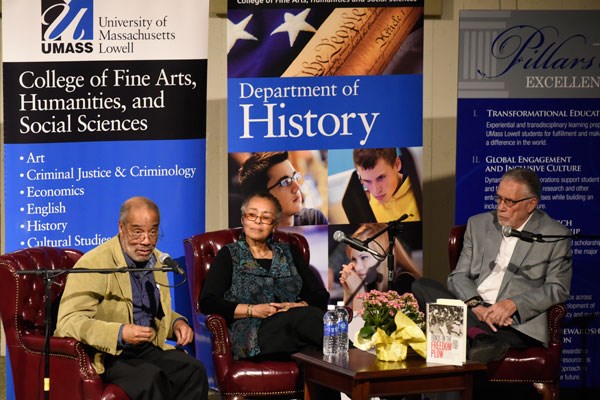Activists, Educators and Students Commemorate 1965 Voting Rights Act

05/27/2015
By Julia Gavin
Campus events commemorating the 50th anniversary of the Voting Rights Act not only celebrated the impact of the landmark legislation but were also a springboard for conversations about ongoing voter suppression, racial tensions and police violence.
The series, organized by History Prof. Robert Forrant and several colleagues, brought activists and historians to campus, engaging students in conversation and work surrounding civil rights and civic action.
“We [the students] are the makers of the future and if we failed in learning the past, what prevents us from repeating the same mistakes over and over again?” said Fabiane Kelley, a history graduate and master’s of education student who attended several of the events. “The Voting Rights Act was much more than President Johnson signing a piece of paper; it was a great victory for the country, hard-fought for by the youth, a lot of them students.”
Learning more about the figures behind the facts that led to the Voting Rights Act made history real for Kelley. And discussing recent developments with people who were present for pivotal moments — such as activists Judy Richardson and Charles Cobb and journalist Callie Crossley, who all came to campus to participate in the events — put the past and present in perspective.
“The passage of the Voting Rights Act marked an important accomplishment for the long civil rights movement in the United States,” said Forrant. “However, with recent Supreme Court decisions chipping away at the act, we need to better understand the history of the struggle for voting rights and rededicate ourselves to continuing the fight for equal rights for all.”
Youth Focus in Historic Movement
A theme throughout the events was the role of young people, specifically students, in supporting the Voting Rights Act. An exhibit of photojournalist and activist Matt Herron’s photos of the 50-mile march from Selma to Montgomery was held at University Crossing, allowing thousands of visitors to see the historic images.
“You might never see the change that you’re working for, but if you do nothing, nothing changes,” said Richardson, who discussed her involvement in the Student Non-Violent Coordinating Committee with Cobb at a panel discussion.
Forrant hopes that by looking at the history of the Civil Rights Act, students are inspired to get civically engaged and remain so in the future.
“At a time when too many people do not exercise their right to vote, it is important for young people to learn just how difficult the fight was for African-Americans to truly obtain that right,” said Forrant. “We should not allow the clock to be turned back through a series of court decisions and the passage of state laws that disenfranchise citizens.”
